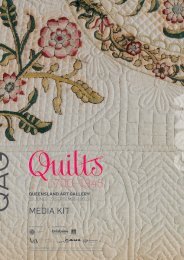Paperskin: barkcloth across the Pacific - Queensland Art Gallery
Paperskin: barkcloth across the Pacific - Queensland Art Gallery
Paperskin: barkcloth across the Pacific - Queensland Art Gallery
You also want an ePaper? Increase the reach of your titles
YUMPU automatically turns print PDFs into web optimized ePapers that Google loves.
information in <strong>barkcloth</strong> designs is not meant to be shared with outsiders. The Omie<br />
women from Oro (or Nor<strong>the</strong>rn) Province, on <strong>the</strong> country’s north-east coast, speak of<br />
<strong>the</strong> cloths as <strong>the</strong>ir ‘wisdom’ and, of <strong>the</strong> symbols in <strong>the</strong>ir works, will recount only those<br />
intended for outsiders. The titles of <strong>the</strong>ir nioje (<strong>barkcloth</strong>s) refer to <strong>the</strong> rich, volcanic<br />
landscape that dominates <strong>the</strong>ir villages, including Mount lamington, mountains with<br />
clouds, jungle vines, tree bark, spider webs, frogs, and <strong>the</strong> backbones of mountain fish.<br />
Yet, each woman imagines this same landscape differently. some like Vivian Marumi<br />
can have entirely different interpretations of <strong>the</strong> same subject — one version of ‘jungle<br />
vines’ shows row upon row of symmetrically freehand horizontal lines as thick as a<br />
canopy. Ano<strong>the</strong>r images this same jungle as chaotic and filled with spirals, diamond<br />
shapes and blocks of colour. This interpretive freedom is bountiful and produces an<br />
incredible diversity in <strong>barkcloth</strong>s made within <strong>the</strong> same small, remote community.<br />
Australian writer Drusilla Modjeska spent time with <strong>the</strong>se artists, and recounts that:<br />
When a woman comes into her vai hero (wisdom), it is not simply that she has learned<br />
<strong>the</strong> iconography, but that she lives it so fully that it forms, and informs, her relationship<br />
with <strong>the</strong> cloth. 5<br />
Modjeska’s engagement with <strong>the</strong> nioje, and her attempt to divulge customary<br />
knowledge of <strong>the</strong> work and practice to a Western audience, is evocative of how o<strong>the</strong>r<br />
<strong>barkcloth</strong> from <strong>the</strong> <strong>Pacific</strong> can be viewed:<br />
While <strong>the</strong> alphabet of motifs can be named, it is absorbed in such a way that parts do<br />
not require naming. The iconography works not by being broken into separate elements,<br />
but by a complex patterning of sensation and image that is not translatable — a way of<br />
seeing that is affective as well as instructive. 6<br />
As with much o<strong>the</strong>r <strong>Pacific</strong> <strong>barkcloth</strong>, <strong>the</strong> Omie’s nioje is a physical manifestation of<br />
<strong>the</strong> makers — who <strong>the</strong>y are, <strong>the</strong>ir locality, <strong>the</strong>ir history and <strong>the</strong>ir cosmology. Titles<br />
of abstract works, such as ‘clan history’ and ‘wisdom’, allude to <strong>the</strong>se textiles’<br />
genealogical memory. The Omie say <strong>the</strong>ir wisdom is intertwined with <strong>the</strong> wellbeing of<br />
12<br />
ABOVE<br />
Vivian Marumi<br />
Papua New Guinea b.1980<br />
Omie people, Oro Province<br />
Odunege 1 (Jungle vines 1) 2006<br />
Barkcloth, dye / 142 x 114cm /<br />
Purchased 2007. <strong>Queensland</strong> <strong>Art</strong><br />
<strong>Gallery</strong> Foundation<br />
RIGHT<br />
Vivian Marumi<br />
Odunege 4 (Jungle vines 4)<br />
(detail) 2006<br />
Barkcloth, dye / 163 x 99cm /<br />
Purchased 2007. <strong>Queensland</strong> <strong>Art</strong><br />
<strong>Gallery</strong> Foundation

















